Multi-Fracture Synchronous Propagation Mechanism of Multi-Clustered Fracturing in Interlayered Tight Sandstone Reservoir
Abstract
:1. Introduction
2. Multiple Fracture Propagation Model of Interlayered Tight Sandstone Reservoir
2.1. Simulation Method
2.2. Establishment of Numerical Model and Parameter Setting
3. Influence of Formation Mechanical Properties on Vertical Propagation of Multiple Clusters of Hydraulic Fractures
3.1. Influence of Vertical In Situ Stress Difference
3.2. Influence of Young’s Modulus of Interlayer
3.3. Influence of the Strength of Lithologic Interface
4. Influence of Fracturing Operation Parameters on Propagation of Multiple Clusters of Hydraulic Fractures
4.1. Influence of Perforation Cluster Spacing
4.2. Influence of Fracturing Fluid Pumping Rate
4.3. Influence of Fracturing Fluid Viscosity
5. Discussion
6. Conclusions
- (1)
- In the multi-clustered fracturing process of interlayered tight sandstone reservoirs, the large vertical stress difference and lithologic interface strength are favorable to hydraulic fracture penetration into the upper and lower interlayers and limit their deflection along the interface. The interlayer Young’s modulus is only related to the longitudinal propagation of hydraulic fractures and has little effect on their deflecting propagation along the interface;
- (2)
- Under the same pumping rate and time, the increase in cluster spacing can improve the longitudinal propagation ability of multiple fractures and weaken the competitive effect of multiple fractures in transverse propagation. The 15 m distance between clusters can make sure that fractures connect to multiple pay layers in the longitudinal direction, and it can make sure that they have an ideal range of propagation in the transverse direction;
- (3)
- Although the multiple clusters of hydraulic fractures’ total length is slightly reduced under the injection rate of 12 m3/min compared with the pumping rate of 8 m3/min, they are ideal for communicating with the adjacent pay layers so as to improve the SRV;
- (4)
- The viscosity of the fracturing fluid is positively related to hydraulic fracture longitudinal penetration ability but negatively related to transverse propagation length. To obtain a larger SRV, the fracturing process needs to inject different viscosities of fracturing fluid at different times.
Author Contributions
Funding
Institutional Review Board Statement
Informed Consent Statement
Data Availability Statement
Conflicts of Interest
References
- Hanson, M.E.; Shaffer, R.J.; Anderson, G.D. Effects of Various Parameters on Hydraulic Fracturing Geometry. SPE J. 1981, 21, 435–443. [Google Scholar] [CrossRef]
- Fu, W.; Ames, B.C.; Bunger, A.P.; Savitski, A.A. Impact of partially cemented and non-persistent natural fractures on hydraulic fracture propagation. Rock Mech. Rock Eng. 2016, 49, 4519–4536. [Google Scholar] [CrossRef]
- Goldstein, R.V.; Osipenko, N.M. Initiation of a secondary crack across a frictional interface. Eng. Fract. Mech. 2015, 140, 92–105. [Google Scholar] [CrossRef]
- Biot, M.A.; Medlin, W.L.; Massé, L. Fracture penetration through an interface. SPE J. 1983, 23, 857–869. [Google Scholar] [CrossRef] [Green Version]
- Guo, J.C.; Luo, B.; Zhu, H.Y.; Yuan, S.H.; Deng, Y.; Duan, Y.J.; Duan, W.G.; Chen, L. Multilayer stress field interference in sandstone and mudstone thin interbed reservoir. J. Geophys. Eng. 2017, 13, 775–785. [Google Scholar] [CrossRef]
- Li, M.; Zhou, F.; Yuan, L.; Chen, L.; Hu, X.; Huang, G.; Han, S. Numerical modeling of multiple fractures competition propagation in the heterogeneous layered formation. Energy Rep. 2021, 7, 3737–3749. [Google Scholar] [CrossRef]
- Liu, Y.; Tang, D.; Xu, H.; Zhao, T.; Hou, W. Effect of interlayer mechanical properties on initiation and propagation of hydraulic fracturing in laminated coal reservoirs. J. Pet. Sci. Eng. 2022, 208, 10391. [Google Scholar] [CrossRef]
- Gao, Q.; Cheng, Y.; Yan, C. A 3D numerical model for investigation of hydraulic fracture configuration in multilayered tight sandstone gas reservoirs. J. Pet. Explor. Prod. Technol. 2018, 8, 1413–1424. [Google Scholar] [CrossRef] [Green Version]
- Qiu, D.; Zhang, J.; Lin, Y.; Liu, J.; Rabiei, M.; Rasouli, V.; Damjanac, B.; Huang, R. Lattice numerical simulations of hydraulic fracture propagation and their geometry evolution in transversely isotropic formations. Front. Earth Sci. 2021, 9, 787736. [Google Scholar] [CrossRef]
- Zhao, H.; Chen, H.; Liu, G.; Li, Y.; Shi, J.; Ren, P. New insight into mechanisms of fracture network generation in shale gas reservoir. J. Pet. Sci. Eng. 2013, 110, 193–198. [Google Scholar]
- Lu, C.; Lu, Y.X.; Guo, J.C.; Liu, L. Stability of the formation interface under the impact of hydraulic fracture propagation in the vicinity of the formation interface. Pet. Sci. 2020, 17, 1101–1118. [Google Scholar] [CrossRef] [Green Version]
- Zhang, J.; Li, Y.W.; Pan, Y.S.; Wang, W.Y.; Yan, M.S.; Shi, X.D.; Zhou, X.J.; Li, H.L. Experiments and analysis on the influence of multiple closed cemented natural fractures on hydraulic fracture propagation in a tight sandstone reservoir. Eng. Geol. 2020, 281, 105981. [Google Scholar] [CrossRef]
- Tan, P.; Jin, Y.; Xiong, Z.; Chen, M.; Hou, B. Effect of interface property on hydraulic fracture vertical propagation behavior in layered formation based on discrete element modeling. J. Geophys. Eng. 2018, 15, 1542–1550. [Google Scholar] [CrossRef] [Green Version]
- Zheng, Y.; Liu, J.; Zhang, B. An investigation into the effects of weak interfaces on fracture height containment in hydraulic fracturing. Energies 2019, 12, 3245. [Google Scholar] [CrossRef] [Green Version]
- Jiang, Y.; Lian, H.; Nguyen, V.; Liang, W. Propagation behavior of hydraulic fracture across the coal-rock interface under different interfacial friction coefficients and a new prediction model. J. Nat. Gas Sci. Eng. 2019, 68, 102894. [Google Scholar] [CrossRef]
- Qin, M.; Yang, D.; Chen, W.; Yang, S. Hydraulic fracturing model of a layered rock mass based on peridynamics. Eng. Fract. Mech. 2021, 258, 108088. [Google Scholar] [CrossRef]
- Smith, M.B.; Bale, A.B.; Britt, L.K.; Klein, H.H.; Siebrits, E.; Dang, X. Layered modulus effects on fracture propagation, proppant placement, and fracture modeling. In Proceedings of the SPE Annual Technical Conference and Exhibition, New Orleans, LA, USA, 30 September–3 October 2001. [Google Scholar]
- Liu, S.; Valkó, P.P. An improved equilibrium-height model for predicting hydraulic fracture height migration in multi-layer formations. In Proceedings of the SPE Hydraulic Fracturing Technology Conference, The Woodlands, TX, USA, 3–5 February 2015. SPE-173335-MS. [Google Scholar]
- Tan, P.; Jin, Y.; Han, K.; Zheng, X.; Hou, B.; Gao, J.; Chen, M.; Zhang, Y. Vertical propagation behavior of hydraulic fractures in coal measure strata based on true triaxial experiment. J. Pet. Sci. Eng. 2017, 158, 398–407. [Google Scholar] [CrossRef]
- Tan, P.; Jin, Y.; Yuan, L.; Xiong, Z.Y.; Hou, B.; Chen, M.; Wan, L.M. Understanding hydraulic fracture propagation behavior in tight sandstone–coal interbedded formations: An experimental investigation. Pet. Sci. 2019, 16, 148–160. [Google Scholar] [CrossRef] [Green Version]
- Fu, S.; Hou, B.; Xia, Y.; Chen, M.; Wang, S.; Tan, P. The study of hydraulic fracture height growth in coal measure shale strata with complex geologic characteristics. J. Pet. Sci. Eng. 2022, 211, 110164. [Google Scholar] [CrossRef]
- Liu, X.; Qu, Z.; Guo, T.; Wang, D.; Tian, Q.; Lv, W. A new chart of hydraulic fracture height prediction based on fluid–solid coupling equations and rock fracture mechanics. R. Soc. Open Sci. 2018, 5, 180600. [Google Scholar] [CrossRef] [Green Version]
- Huang, L.; Liu, J.; Zhang, F.; Fu, H.; Zhu, H.; Damjanac, B. 3D lattice modeling of hydraulic fracture initiation and near-wellbore propagation for different perforation models. J. Pet. Sci. Eng. 2020, 191, 107169. [Google Scholar] [CrossRef]
- Damjanac, B.; Cundall, P. Application of distinct element methods to simulation of hydraulic fracturing in naturally fractured reservoirs. Comput. Geotech. 2015, 6, 7. [Google Scholar] [CrossRef]
- Cong, Z.; Li, Y.; Tang, J.; Martyushev, D.A.; Hu, B.; Yang, F. Numerical simulation of hydraulic fracture height layer-through propagation based on three-dimensional lattice method. Eng. Fract. Mech. 2022, 264, 108331. [Google Scholar] [CrossRef]
- Westwood, R.F.; Toon, S.M.; Cassidy, N.J. A sensitivity analysis of the effect of pumping parameters on hydraulic fracture networks and local stresses during shale gas operations. Fuel 2017, 203, 843–852. [Google Scholar] [CrossRef]
- Guo, D.; Kang, Y.; Wang, Z.; Li, S. Optimization of fracturing parameters for tight oil production based on genetic algorithm. Petroleum 2021, 8, 252–263. [Google Scholar] [CrossRef]
- Michael, A. Hydraulic fractures from non-Uniform perforation cluster spacing in horizontal wells: Laboratory Testing on Transparent Gelatin. J. Nat. Gas Sci. Eng. 2021, 9, 104158. [Google Scholar] [CrossRef]
- Ren, L.; Lin, R.; Zhao, J.; Wu, L. An optimal design of cluster spacing intervals for staged fracturing in horizontal shale gas wells based on the optimal SRVs. Nat. Gas Ind. 2017, 4, 364–373. [Google Scholar] [CrossRef]
- Qin, M.; Yang, D.; Chen, W. Numerical investigation of the effects of fracturing fluid parameters on hydraulic fracture propagation in jointed rock mass based on peridynamics. Eng. Anal. Bound. Elem. 2022, 135, 38–51. [Google Scholar] [CrossRef]
- Zhao, Y.; Zhang, Y.; Yang, H.; Liu, Q.; Tian, G. Experimental study on relationship between fracture propagation and pumping parameters under constant pressure injection conditions. Fuel 2022, 307, 121789. [Google Scholar] [CrossRef]
- Liu, C.; Shi, F.; Zhang, Y.; Deng, D.; Wang, X.; Liu, H.; Wu, H. High injection rate stimulation for improving the fracture complexity in tight-oil sandstone reservoirs. J. Nat. Gas Sci. Eng. 2017, 42, 133–141. [Google Scholar] [CrossRef]
- Huang, L.; Dontsov, E.; Fu, H.; Lei, Y.; Weng, D.; Zhang, F. Hydraulic fracture height growth in layered rocks: Perspective from DEM simulation of different propagation regimes. Int. J. Solids Struct. 2022, 238, 111395. [Google Scholar] [CrossRef]
- Wasantha, P.; Xu, T.; Xu, B. Effect of fluid injection rate on the hydraulic fracture propagation characteristics. IOP Conf. Ser. Earth Environ. Sci. 2021, 861, 032095. [Google Scholar] [CrossRef]
- Cao, M.; Hirose, S.; Sharma, M.M. Factors controlling the formation of complex fracture networks in naturally fractured geothermal reservoirs. J. Pet. Sci. Eng. 2021, 208, 109642. [Google Scholar] [CrossRef]
- Yi, L.; Yang, C.; Chen, R.; Zhu, J.; Zhu, X.; Yang, Z.; Li, X. Phase field model for hydraulic fracture propagation in porous medium and numerical simulation analysis of hydraulic fracture propagation in a layered reservoir. Arab. J. Geosci. 2021, 14, 1599. [Google Scholar] [CrossRef]
- Li, Y.; Long, M.; Tang, J.; Chen, M.; Fu, X. A hydraulic fracture height mathematical model considering the influence of plastic region at fracture tip. Pet. Explor. Dev. 2020, 47, 184–195. [Google Scholar] [CrossRef]
- Li, Y.; Long, M.; Zuo, L.; Li, W.; Zhao, W. Brittleness evaluation of coal based on statistical damage and energy evolution theory. J. Pet. Sci. Eng. 2019, 172, 753–763. [Google Scholar] [CrossRef]
- Zou, Y.; Zhang, S.; Ma, X.; Zhou, T.; Zeng, B. Numerical investigation of hydraulic fracture network propagation in naturally fractured shale formations. J. Struct. Geol. 2016, 84, 1–13. [Google Scholar] [CrossRef]
- Hou, B.; Chang, Z.; Fu, W.; Muhadasi, Y.; Chen, M. Fracture initiation and propagation in deep shale gas reservoir subject to alternating fluid injection hydraulic fracturing treatment. SPE J. 2019, 24, 1839–1855. [Google Scholar] [CrossRef]
- Hu, Y.; Wang, Q.; Zhao, J.; Chen, S.; Zhao, C.; Fu, C. Three-dimensional complex fracture propagation simulation: Implications for rapid decline of production capacity. Energy Sci. Eng. 2020, 8, 4196–4211. [Google Scholar] [CrossRef]
- Cong, Z.; Li, Y.; Pan, Y.; Liu, B.; Shi, Y.; Wei, J.; Li, W. Study on CO2 foam fracturing model and fracture propagation simulation. Energy 2022, 238, 121778. [Google Scholar] [CrossRef]
- Janiszewski, M.; Shen, B.; Rinne, M. Simulation of the interactions between hydraulic and natural fractures using a fracture mechanics approach. J. Rock Mech. Geotech. Eng. 2019, 11, 1138–1150. [Google Scholar] [CrossRef]
- Wu, J.; Huang, H.; Xu, E.; Li, J.; Wang, X. Numerical investigation on propagation behaviors of a three-dimensional fracture network coupled with microseismicity in fractured shale reservoirs. Energies 2021, 14, 8297. [Google Scholar] [CrossRef]
- Zhao, K.; Li, R.; Lei, H.; Gao, W.; Zhang, Z.; Wang, X.; Qu, L. Numerical simulation of influencing factors of hydraulic fracture network development in reservoirs with pre-existing fractures. Processes 2022, 10, 773. [Google Scholar] [CrossRef]
- Li, Y.; Zhao, Y.; Tang, J.; Zhang, L.; Zhou, Y.; Zhu, X.; Jia, D.; Chen, M. Rock damage evolution model of pulsating fracturing based on energy evolution theory. Energy Sci. Eng. 2020, 8, 1050–1067. [Google Scholar] [CrossRef]



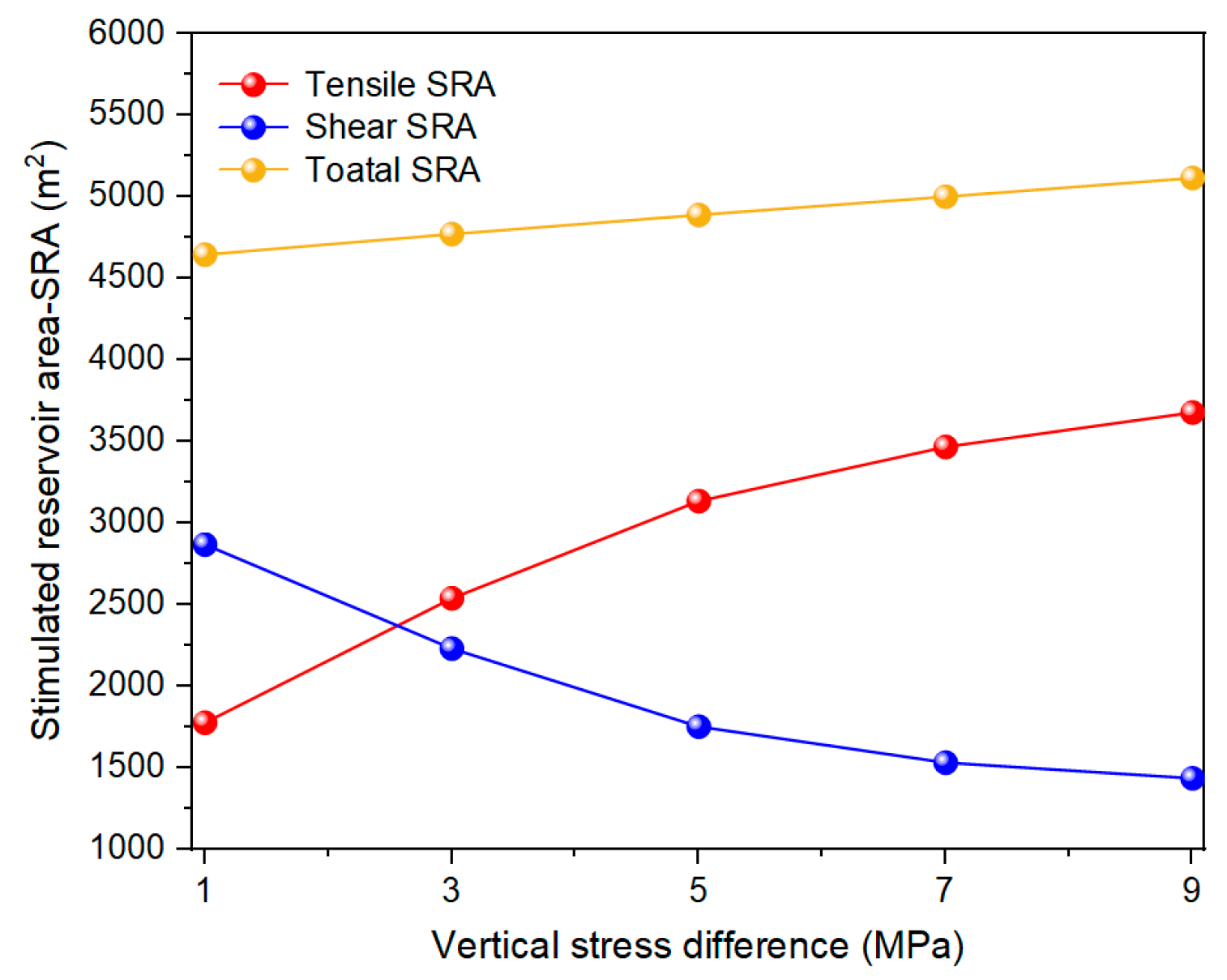
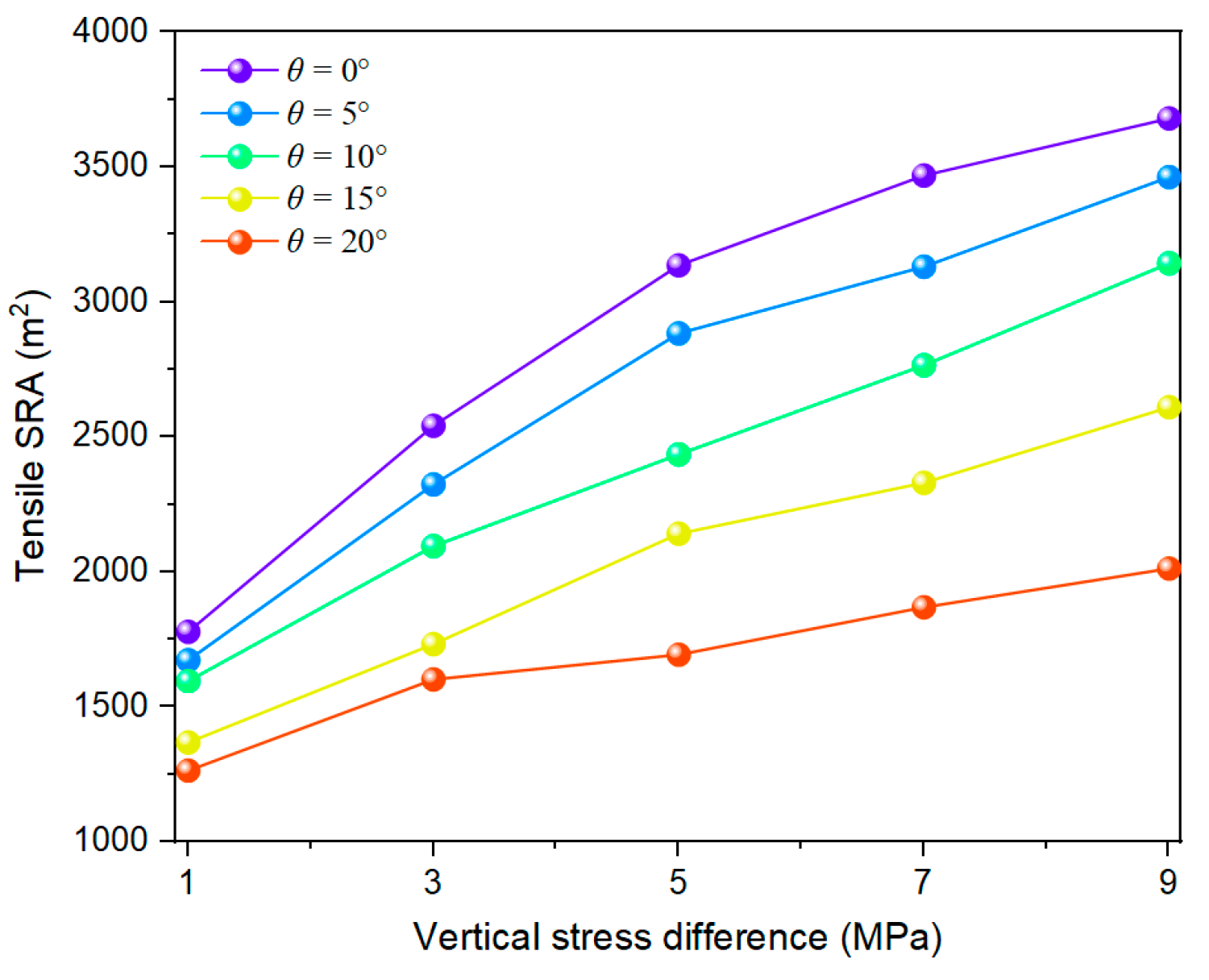


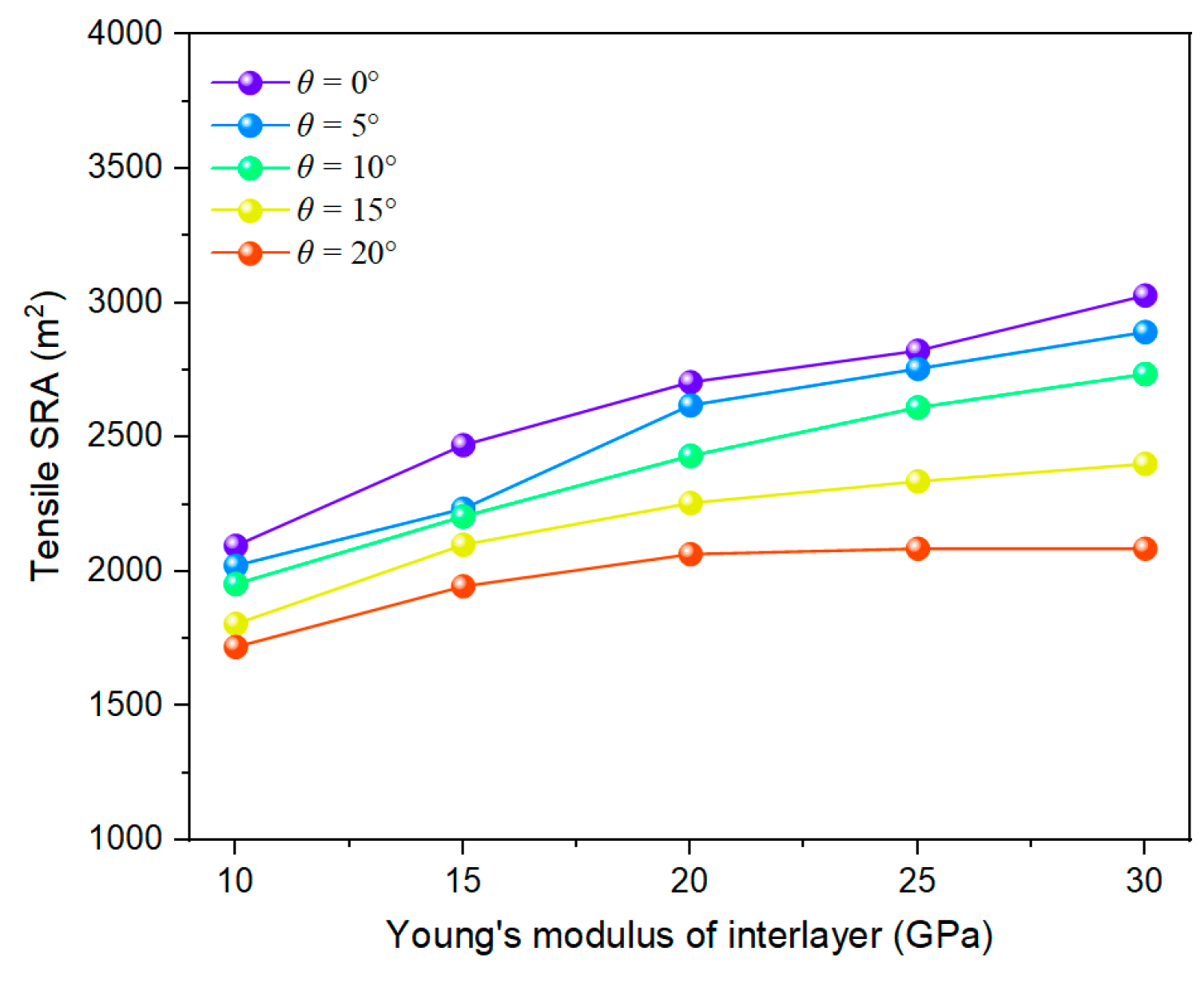

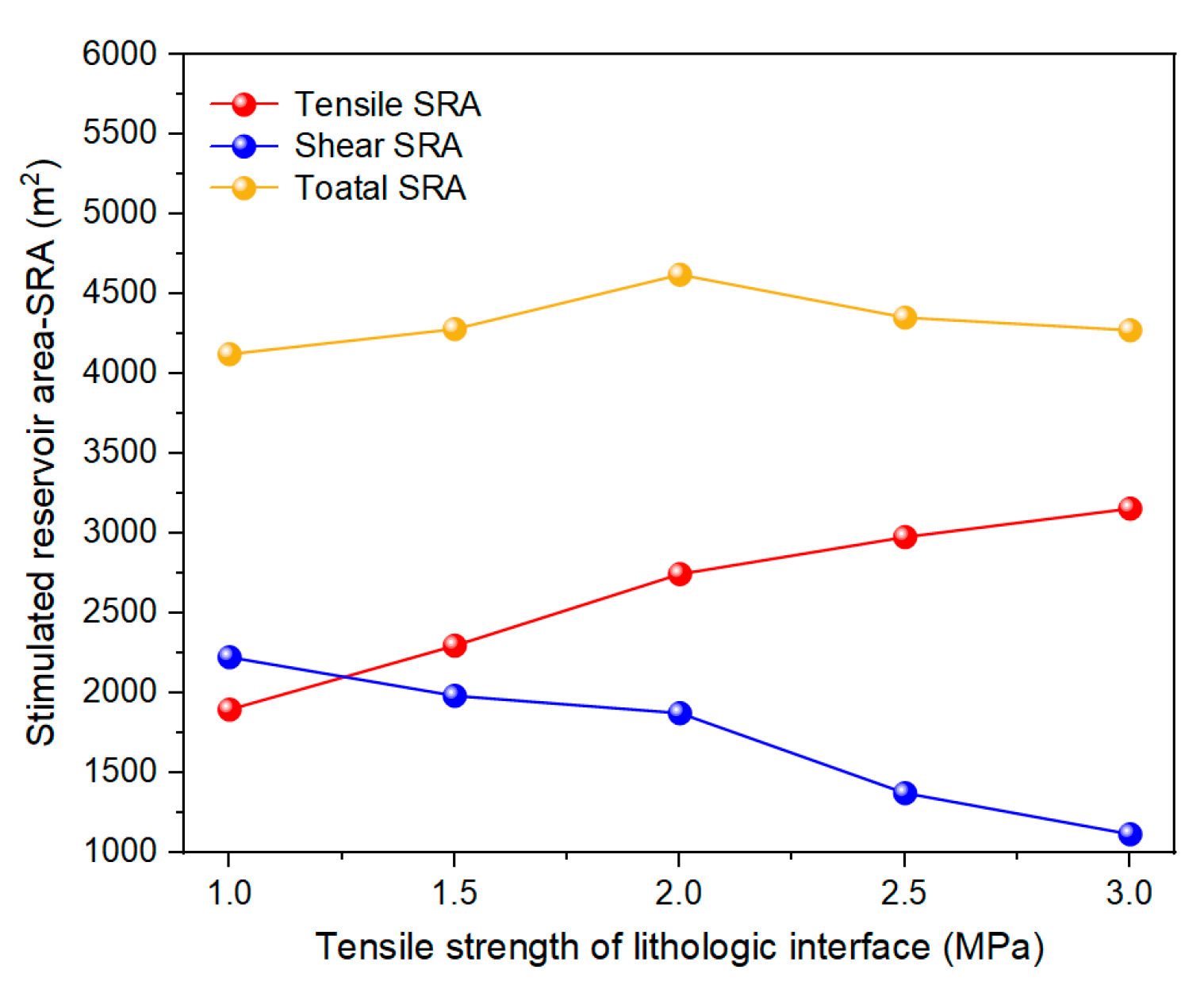
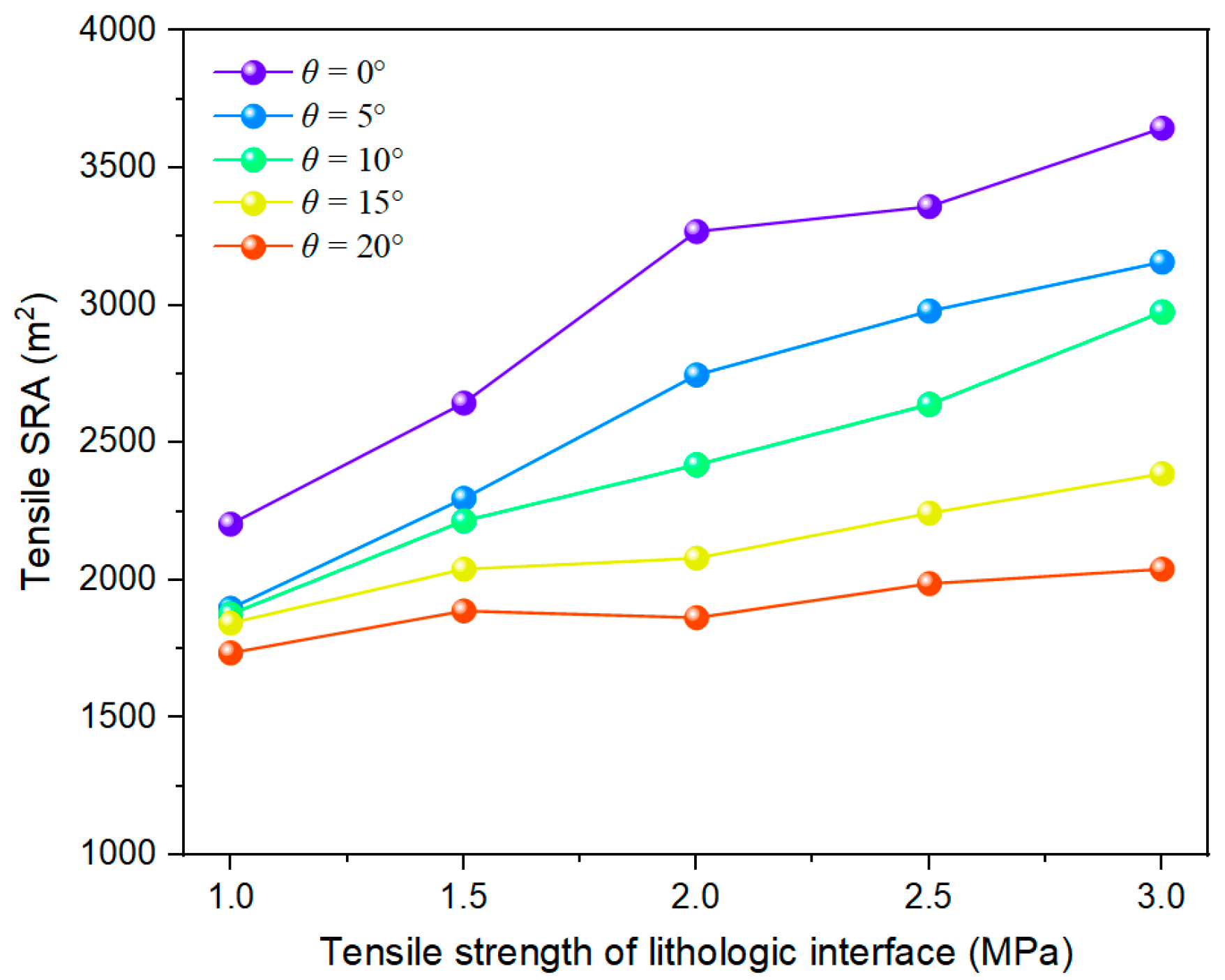
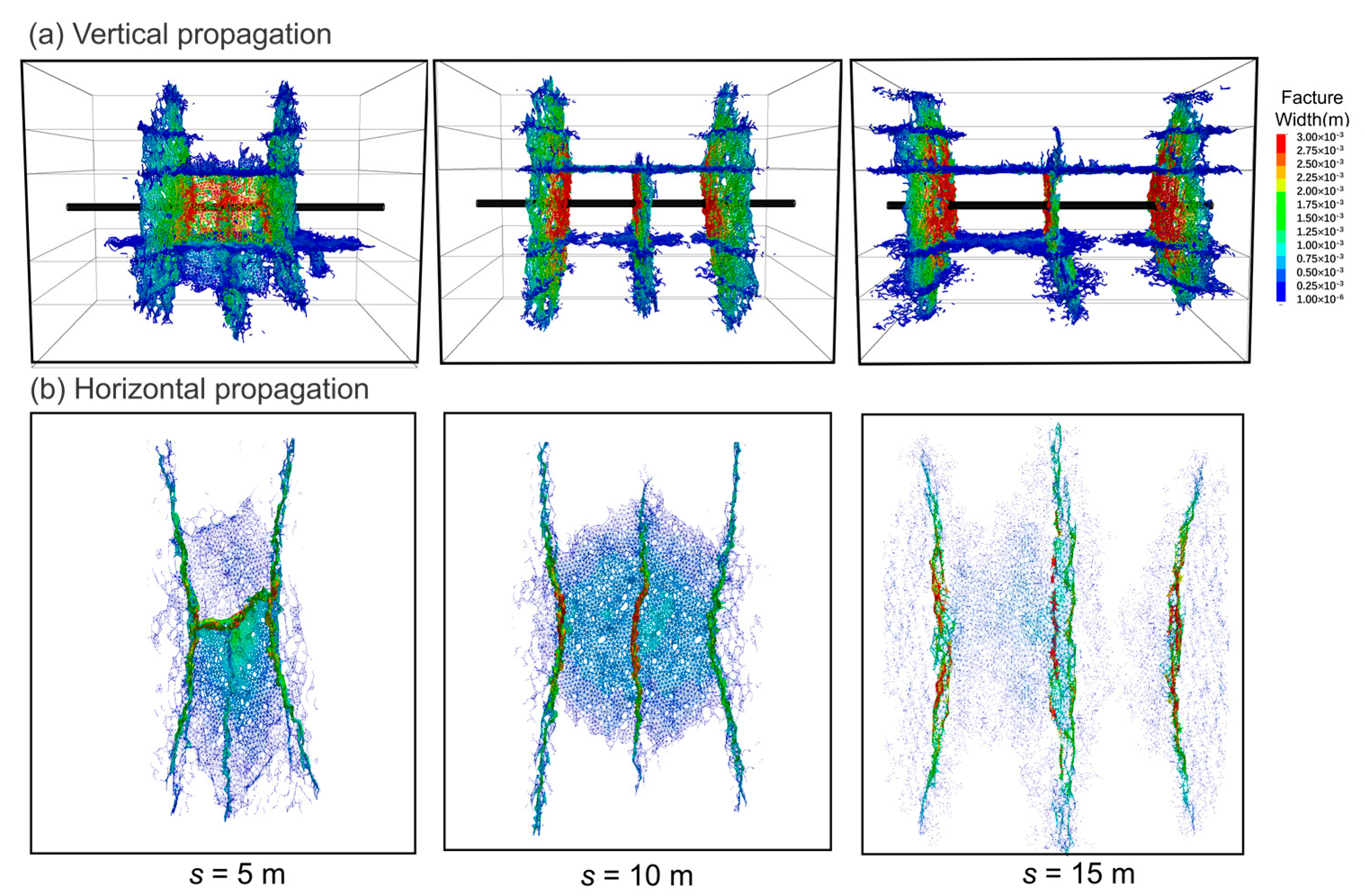

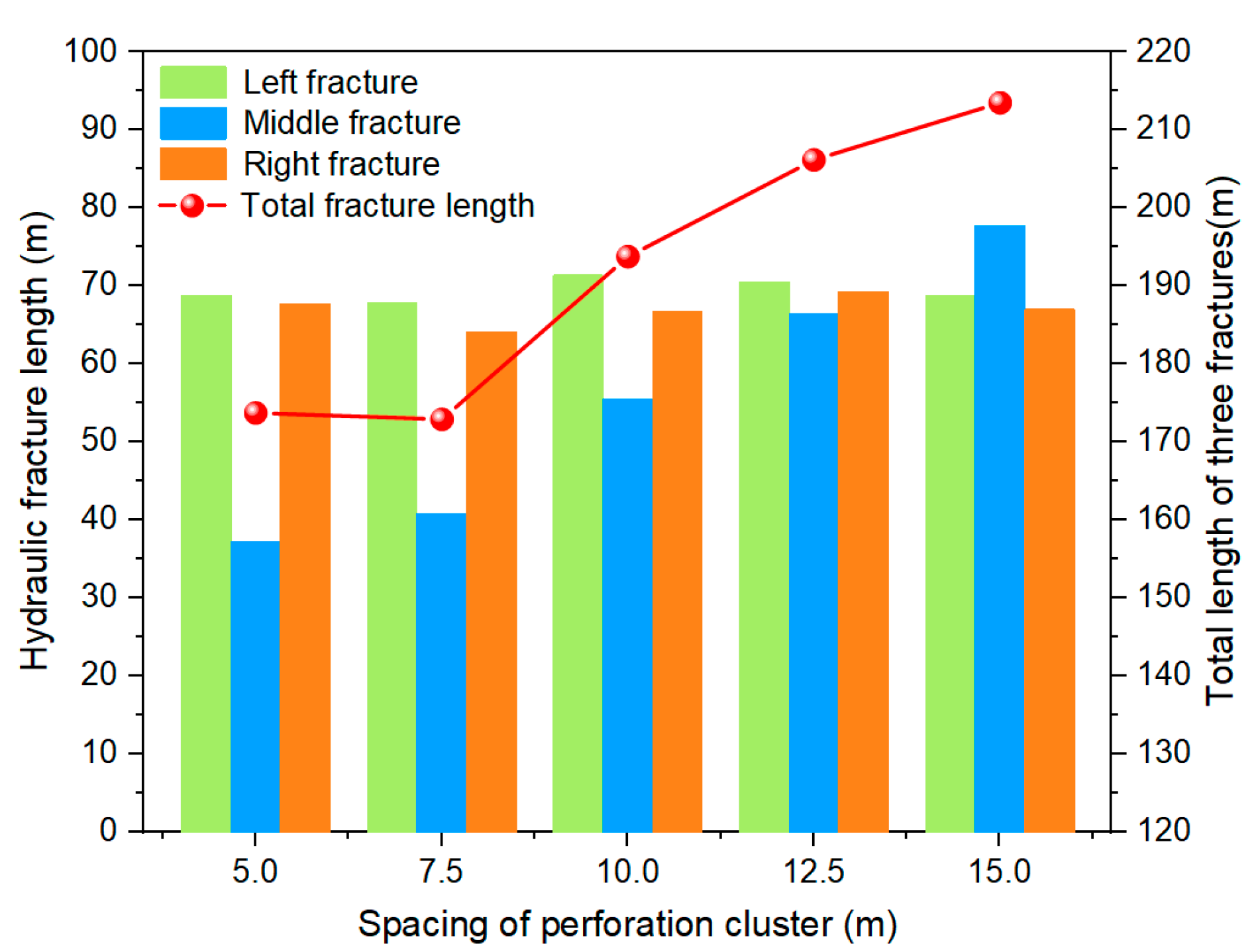
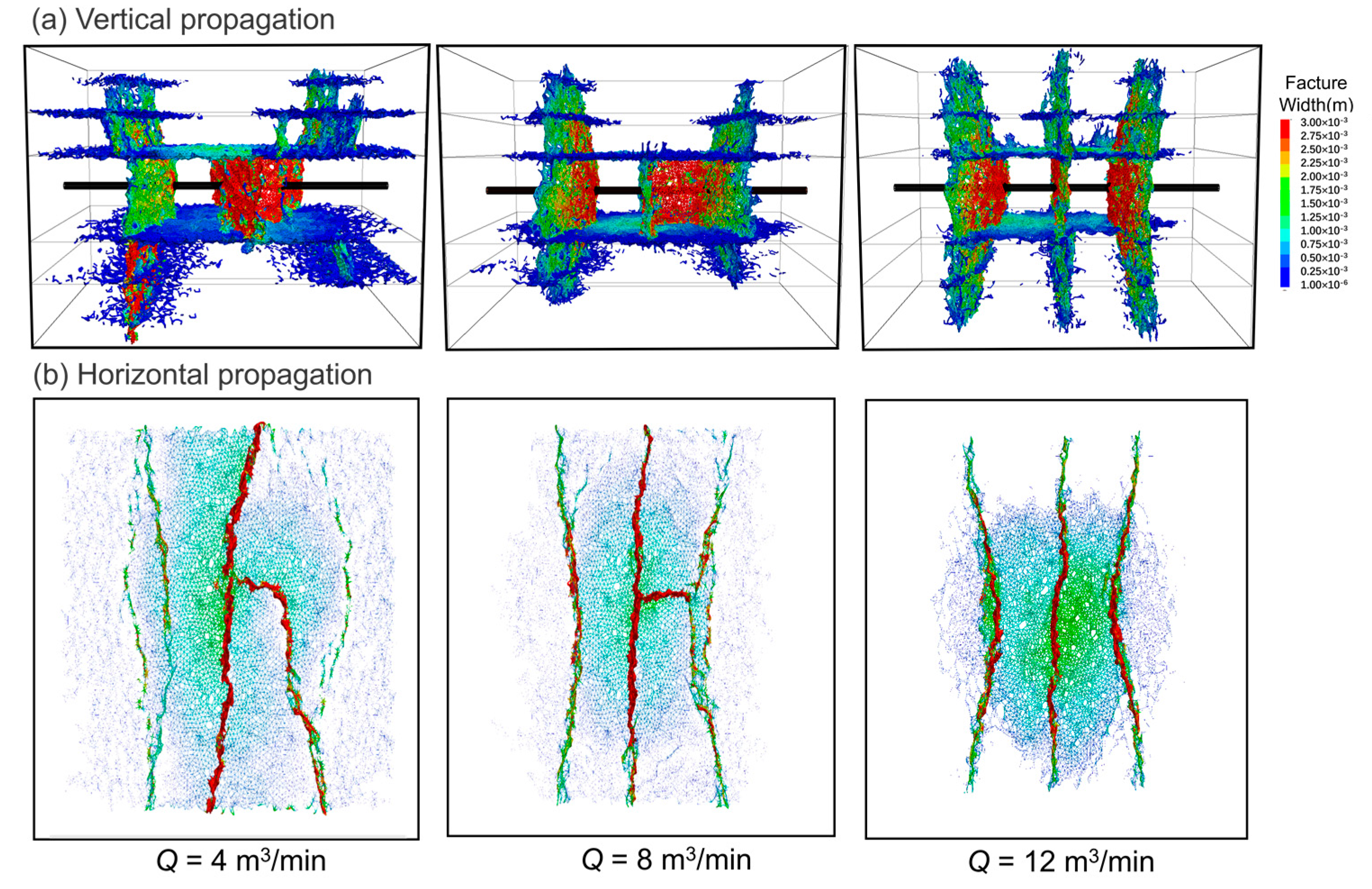

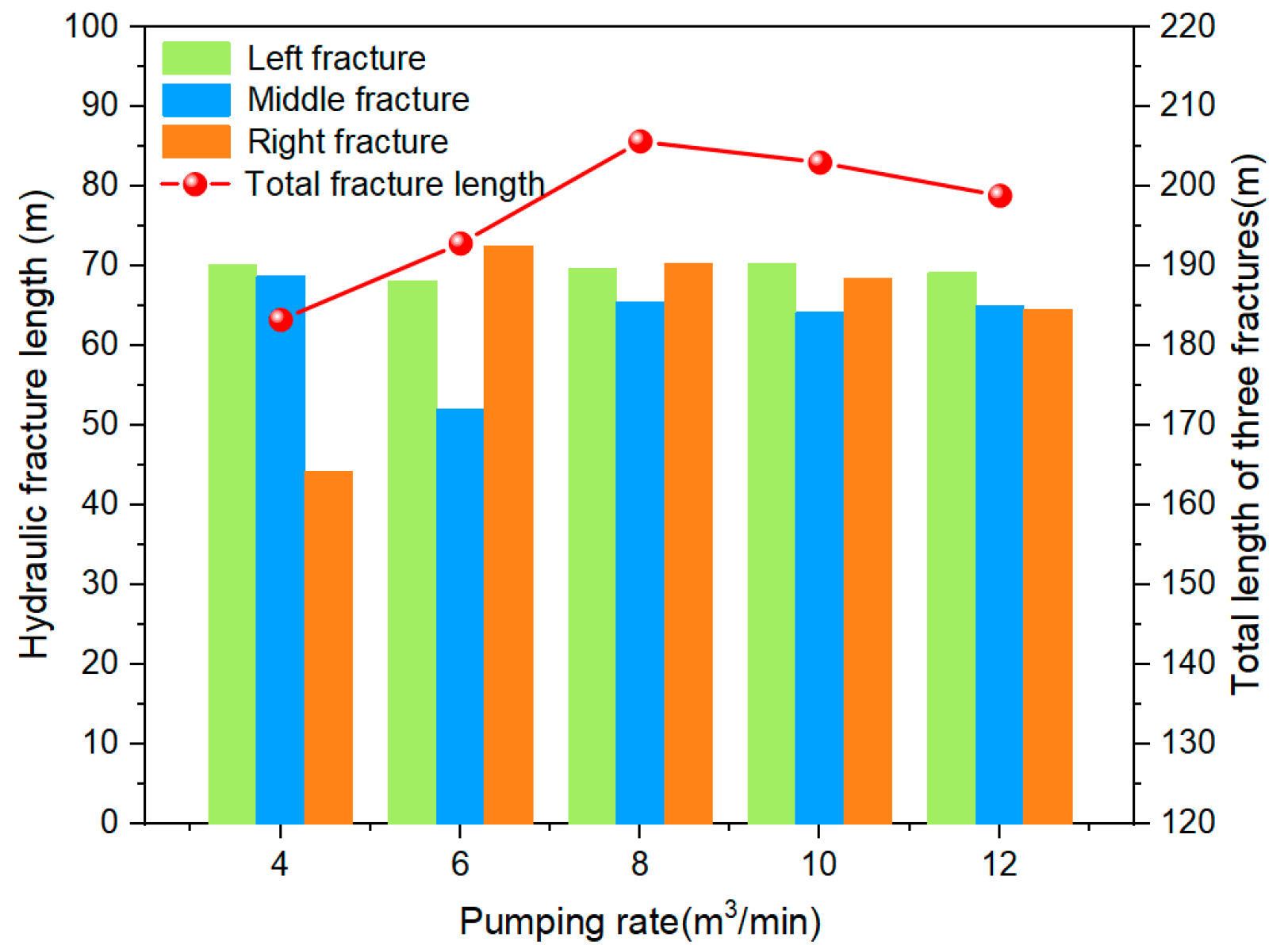
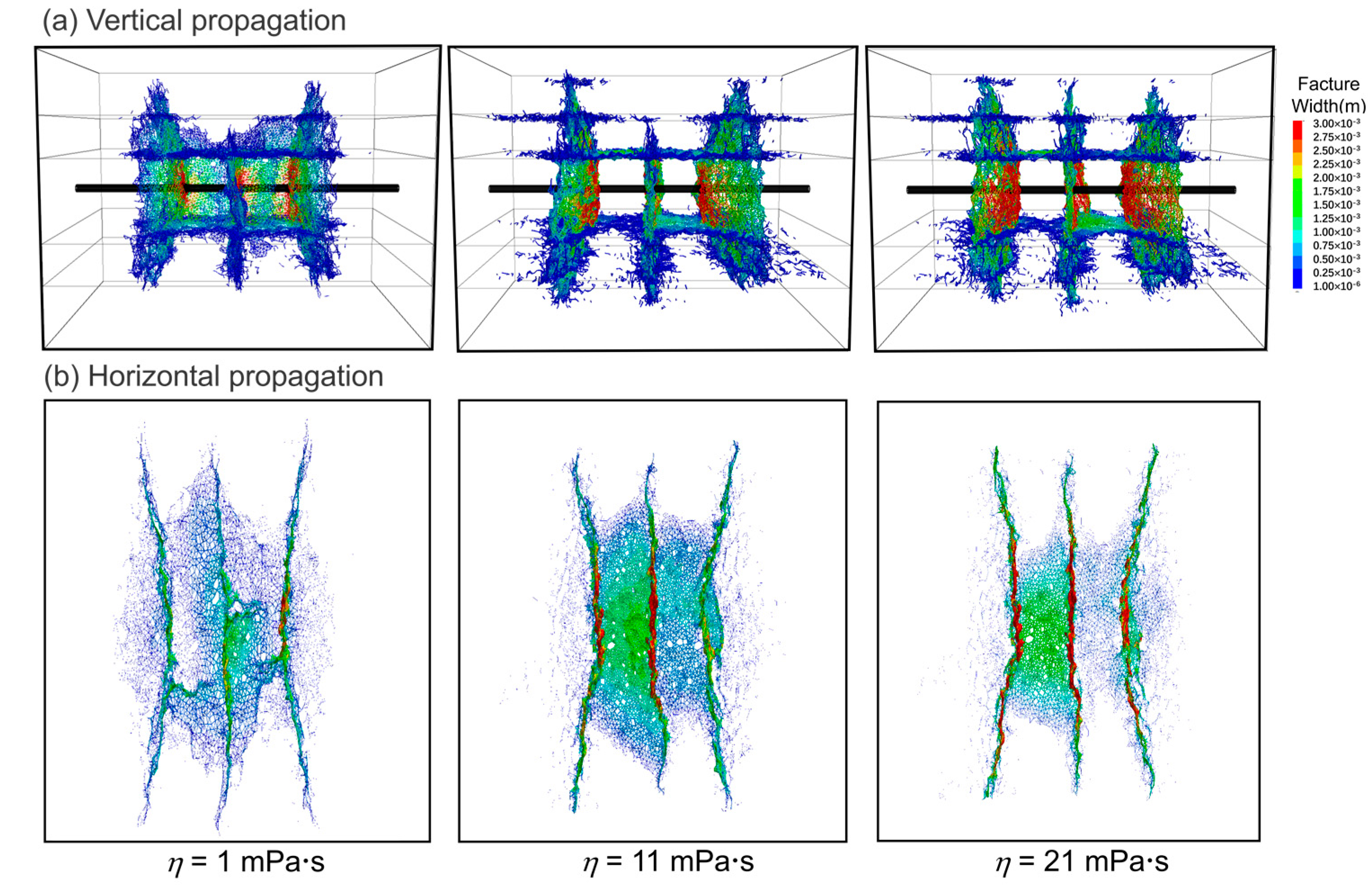

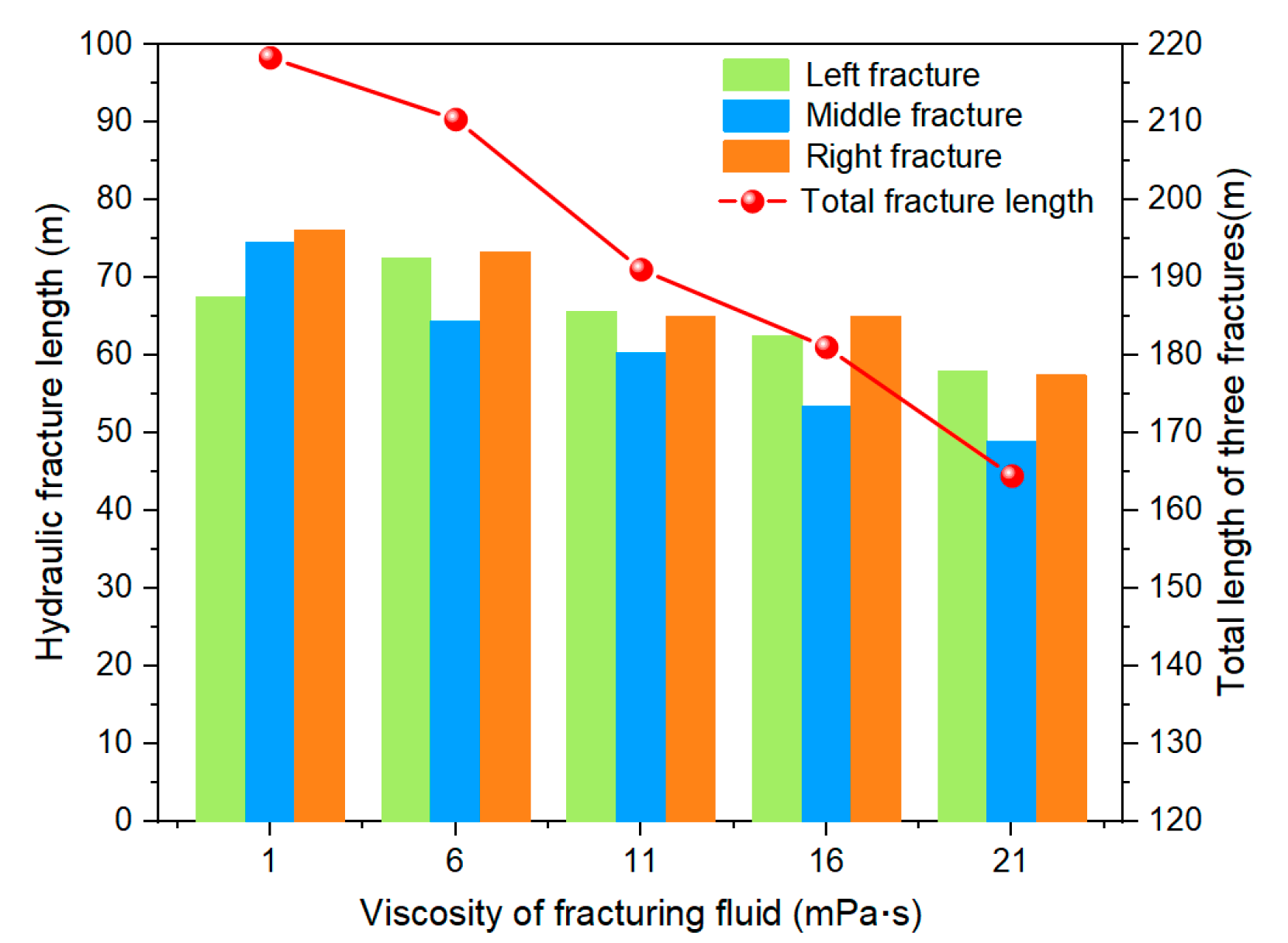
| Parameters | Pay Layer | Interlayer |
|---|---|---|
| Tensile strength (MPa) | 3.5 | 4.5 |
| Uniaxial compressive strength (MPa) | 79.5 | 89.5 |
| Young’s modulus (GPa) | 26.2 | 21.2 |
| Poisson’s ratio | 0.22 | 0.23 |
| Permeability (10−15 m2) | 0.5 | 1.2 |
| Vertical in-situ stress (MPa) | 38 | 38 |
| Minimum horizontal principal stress (MPa) | 35 | 35 |
| Maximum horizontal principal stress (MPa) | 40 | 40 |
| Pumping rate of fracturing fluid (m3/min) | 8 | |
| Viscosity of fracturing fluid (MPa·s) | 6 | |
Publisher’s Note: MDPI stays neutral with regard to jurisdictional claims in published maps and institutional affiliations. |
© 2022 by the authors. Licensee MDPI, Basel, Switzerland. This article is an open access article distributed under the terms and conditions of the Creative Commons Attribution (CC BY) license (https://creativecommons.org/licenses/by/4.0/).
Share and Cite
Tian, F.; Jin, Y.; Jin, F.; Ma, X.; Shi, L.; Zhang, J.; Qiu, D.; Zhang, Z. Multi-Fracture Synchronous Propagation Mechanism of Multi-Clustered Fracturing in Interlayered Tight Sandstone Reservoir. Sustainability 2022, 14, 8768. https://doi.org/10.3390/su14148768
Tian F, Jin Y, Jin F, Ma X, Shi L, Zhang J, Qiu D, Zhang Z. Multi-Fracture Synchronous Propagation Mechanism of Multi-Clustered Fracturing in Interlayered Tight Sandstone Reservoir. Sustainability. 2022; 14(14):8768. https://doi.org/10.3390/su14148768
Chicago/Turabian StyleTian, Fuchun, Yan Jin, Fengming Jin, Xiaonan Ma, Lin Shi, Jun Zhang, Dezhi Qiu, and Zhuo Zhang. 2022. "Multi-Fracture Synchronous Propagation Mechanism of Multi-Clustered Fracturing in Interlayered Tight Sandstone Reservoir" Sustainability 14, no. 14: 8768. https://doi.org/10.3390/su14148768
APA StyleTian, F., Jin, Y., Jin, F., Ma, X., Shi, L., Zhang, J., Qiu, D., & Zhang, Z. (2022). Multi-Fracture Synchronous Propagation Mechanism of Multi-Clustered Fracturing in Interlayered Tight Sandstone Reservoir. Sustainability, 14(14), 8768. https://doi.org/10.3390/su14148768





